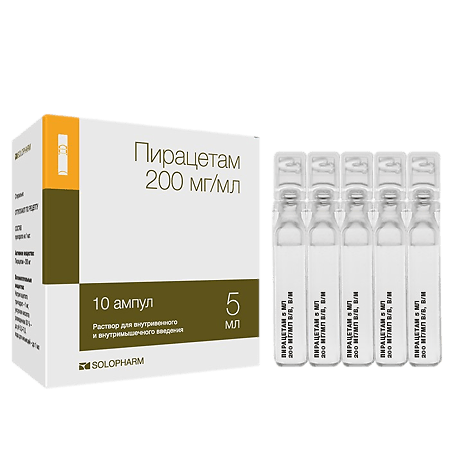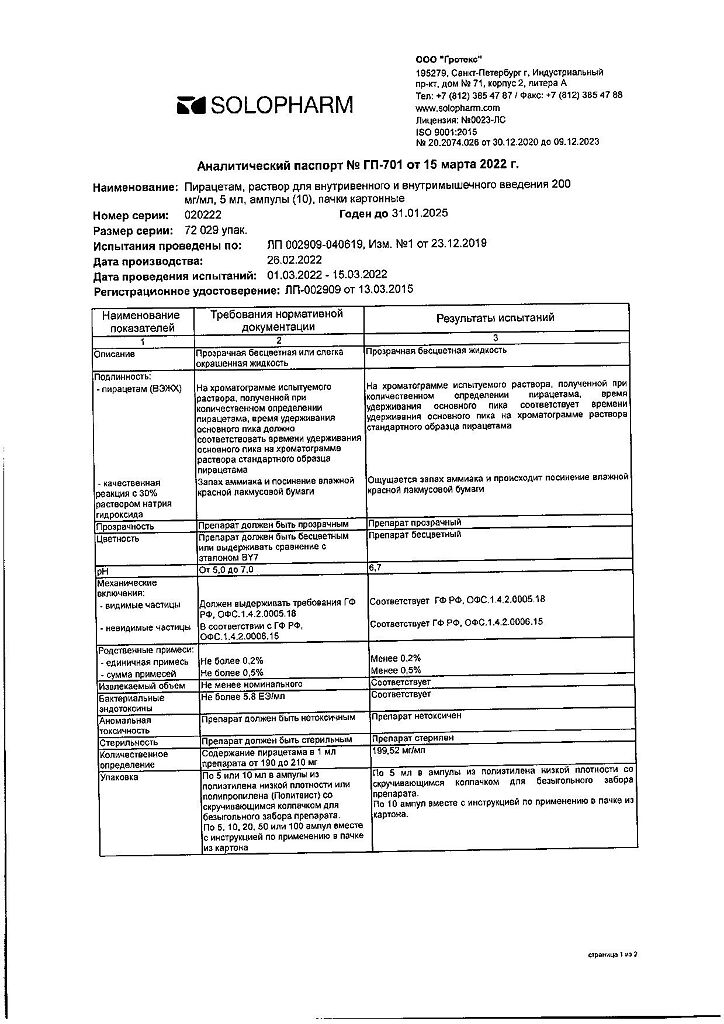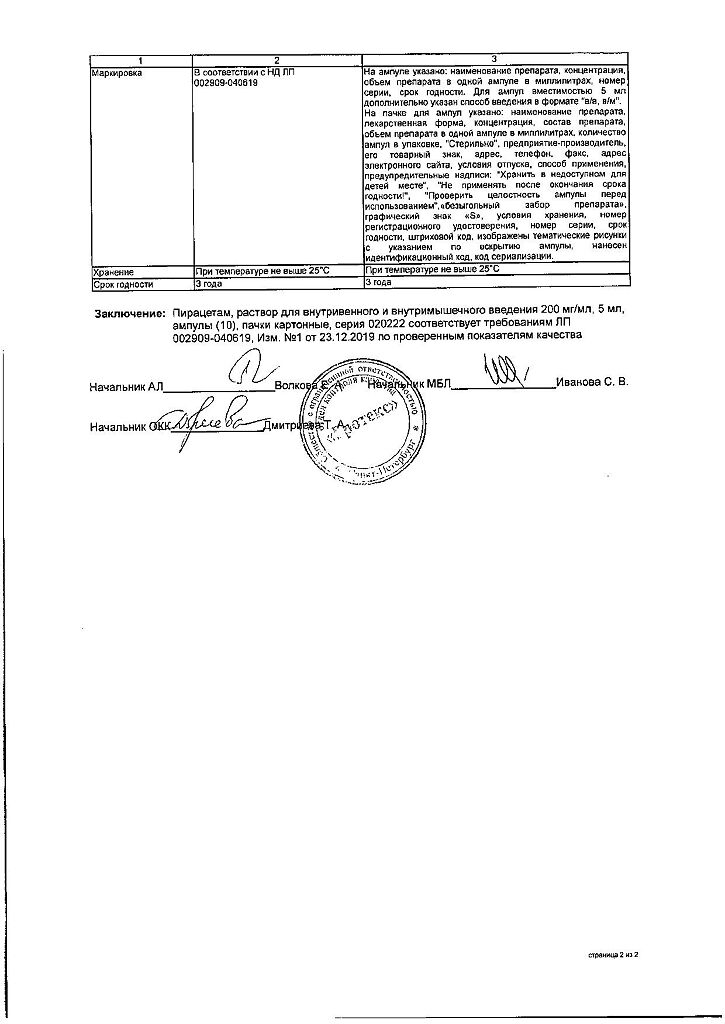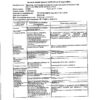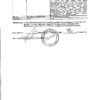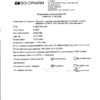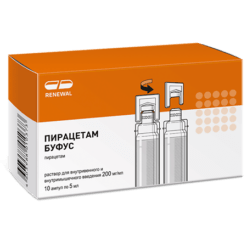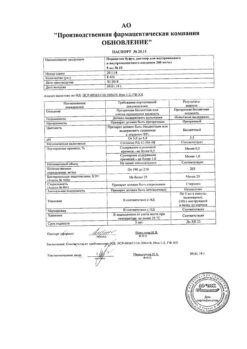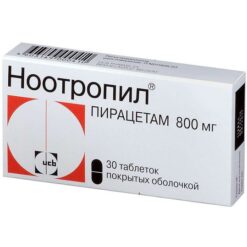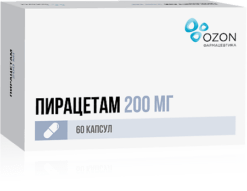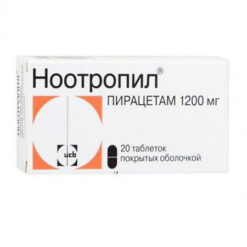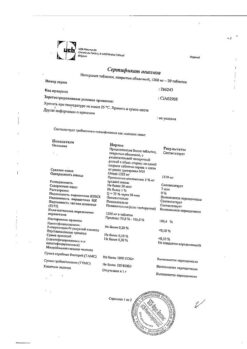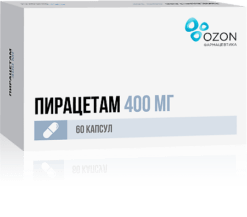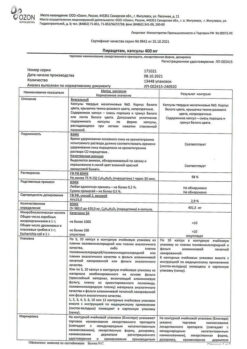No products in the cart.
Piracetam, 200 mg/ml 5 ml 10 pcs
€3.76 €3.42
Description
The active ingredient is piracetam, a cyclic derivative of gamma-aminobutyric acid (GABA).
Piracetam is a nootropic which directly affects the brain, improving cognitive (learning) processes such as learning, memory, attention, and mental performance.
Piracetam affects the CNS in different ways: by changing the speed of propagation of excitation in the brain, improves metabolic processes in nerve cells, improves microcirculation, affects the rheological characteristics of the blood, without having a vasodilatory effect. It improves communication between the cerebral hemispheres and synaptic conduction in the neocortical structures, improves cerebral blood flow.
Piracetam inhibits platelet aggregation and restores the configuration properties of the outer membrane of rigid red blood cells, as well as the ability of the latter to pass through the vessels of the microcircular bed. At a dose of 9.6 g it reduces the concentration of fibrinogen and Willebrand factors by 30-40 % and prolongs the bleeding time. Piracetam has a protective and restorative effect in cases of brain dysfunction due to hypoxia and intoxication.
Piracetam reduces the severity and duration of vestibular nystagmus.
Indications
Indications
Symptomatic treatment of intellectual-mnestic disorders in the absence of an established diagnosis of dementia;
reducing the manifestations of cortical myoclonus in patients sensitive to piracetam, both as monotherapy and as part of complex therapy (in order to determine sensitivity to piracetam in a particular case, a trial course of treatment can be carried out).
Pharmacological effect
Pharmacological effect
Pharmacotherapeutic group
Nootropic drug
ATX code: N06BX03
Pharmacodynamics:
The active component is piracetam, a cyclic derivative of gamma-aminobutyric acid (GABA).
Piracetam is a nootropic that directly affects the brain, improving cognitive processes such as learning, memory, attention, and mental performance. Piracetam affects the central nervous system (CNS) in various ways: by changing the speed of propagation of excitation in the brain, improving metabolic processes in nerve cells, improving microcirculation, affecting the rheological characteristics of the blood, without having a vasodilating effect. Improves connections between the cerebral hemispheres and synaptic conduction in neocortical structures, increases mental performance, improves cerebral blood flow;
Piracetam inhibits platelet aggregation and restores the elasticity of the erythrocyte membrane, reduces the adhesion of erythrocytes. At a dose of 9.6 g, it reduces the level of fibrinogen and von Willebrand factor by 30-40% and prolongs bleeding time. Piracetam has a protective and restorative effect in cases of impaired brain function due to hypoxia and intoxication.
Piracetam reduces the severity and duration of vestibular nystagmus.
Pharmacokinetics:
The half-life of the drug from blood plasma is 4-5 hours and 8.5 hours from cerebrospinal fluid, which is prolonged in case of renal failure.
The pharmacokinetics of piracetam does not change in patients with liver failure. Penetrates the blood-brain and placental barriers and membranes used in hemodialysis. In animal studies, piracetam selectively accumulated in cortical tissues, predominantly in the frontal, parietal and occipital lobes in the cerebellum and basal ganglia. It does not bind to blood plasma proteins, is not metabolized in the body, and is excreted unchanged by the kidneys through renal filtration. The renal clearance of piracetam in healthy volunteers is 86 ml/min.
Special instructions
Special instructions
Prescribe with caution to patients with impaired hemostasis, before upcoming major surgical interventions, or in patients with symptoms of severe bleeding.
When treating cortical myoclonus, abrupt cessation of treatment should be avoided, as this may cause recurrence of attacks.
During long-term therapy in elderly patients, regular monitoring of renal function is recommended; if necessary, dose adjustment is carried out depending on QC.
Penetrates through the filter membranes of hemodialysis machines.
Impact on the ability to drive vehicles and operate machinery
During the treatment period, care must be taken when driving vehicles and engaging in other potentially hazardous activities that require increased concentration and speed of psychomotor reactions.
Active ingredient
Active ingredient
Piracetam
Composition
Composition
1 ml of solution contains:
active substance: piracetam – 200 mg;
excipients: sodium acetate – 1 mg, acetic acid – up to pH 5.8, water for injection – up to 1 ml.
Contraindications
Contraindications
– severe chronic renal failure (creatinine clearance (CK) less than 20 ml/min);
– hemorrhagic stroke;
– psychomotor agitation;
– Huntington’s chorea;
— pregnancy;
— lactation period.
With caution: impaired hemostasis; extensive surgical interventions; heavy bleeding; chronic renal failure (KK 20-80 ml/min).
Side Effects
Side Effects
From the side of the central nervous system: motor disinhibition, irritability, drowsiness, depression, asthenia, headache, insomnia, mental agitation, imbalance, ataxia, exacerbation of epilepsy, anxiety, hallucinations, confusion.
From the digestive system: nausea, vomiting, diarrhea, abdominal pain.
Metabolism: increased body weight. From the senses: vertigo.
From the skin: dermatitis, itching, rashes.
Allergic reactions: hypersensitivity, anaphylactic reactions, angioedema.
Local reactions: pain at the injection site, thrombophlebitis. Other: fever, decreased blood pressure.
Interaction
Interaction
When used simultaneously with iodine-containing thyroid hormones, confusion, irritability and sleep disturbance may occur.
In high doses (9.6 g/day) in patients with venous thrombosis, it increases the anticoagulant effect of indirect anticoagulants (a more pronounced decrease in platelet aggregation, fibrinogen content, von Willebrand factor, blood and plasma viscosity).
Pharmaceutically compatible with solutions of dextrose (5%, 10%, 20%), fructose (5%, 10%, 20%), 0.9% sodium chloride solution, Ringer’s solution, 20% mannitol solution, hydroxyethyl starch (6%, 10%).
Overdose
Overdose
Symptoms: abdominal pain, bloody diarrhea.
Treatment: induction of vomiting, gastric lavage, symptomatic therapy, hemodialysis (effectiveness 50-60%). There is no specific antidote.
Manufacturer
Manufacturer
Grotex LLC, Russia
Additional information
| Manufacturer | Grotex Ltd, Russia |
|---|---|
| Medication form | solution |
| Brand | Grotex Ltd |
Other forms…
Related products
Buy Piracetam, 200 mg/ml 5 ml 10 pcs with delivery to USA, UK, Europe and over 120 other countries.

